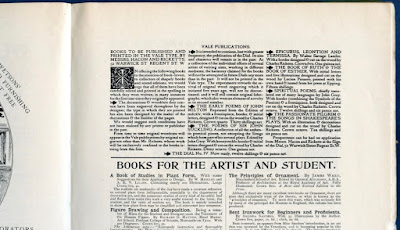Such catalogues, usually, were not subject to criticism, but in this case D.S. MacColl, in The Saturday Review of 10 December 1898 (pp. 778-779) made an exception.
He started out very positive:
A charming exhibition is now open at the Dutch Gallery in Brook Street. It brings together the work done in original wood-engraving by Messrs. Ricketts and Shannon and their associates, Messrs. Sturge Moore, Reginald Savage and Lucien Pissarro.
After praising Ricketts's and Shannon's work for The Dial, and their early wood-engravings for Daphnis and Chloe, and before praising Shannon's new work in another medium, the chiaroscuro wood-engravings, he paused to criticise the exhibition catalogue:
 |
| The First Exhibition of Original Wood Engraving (1898) [catalogue, page 1] |
Mr. Ricketts’ later work in “Hero and Leander,” “Cupid and Psyche,” and some of his books seems to me less perfectly balanced, more strained, form sacrificed in the effort at gesture and intense expression, or swept into decorative curves. The discussion of his type and books I must leave for another time, since it demands a detailed treatment.
The criticism only focused on the cover (also the title page):
I will only raise one point for the moment, taking the title of the catalogue as a text. This, giving the name of the exhibition and its address, is printed like the old colophons in one block without a break, and not only is it difficult at a glance to pick out and read these two statements, but the arrangement requires minor dislocations. The word “engraving” is divided between two lines; “Hanover” ends one line, and “Square” begins another. I contend that lucidity would be the gainer by a different arrangement, and decoration need not in the least suffer.
These unfortunate truncations had been the subject of earlier criticism when the first publications of the Vale Press were given eccentric title pages in which rules of poetry were sometimes hindered by the decorations or initials. Ricketts would later express his regret about his youthful, ill-considered typographical designs, although he rejected any criticism of his fonts.
But the small catalogues for Van Wisselingh were part of the occasional printing process, which did not involve much typographical ingenuity. They were merely mentioned in passing in his own bibliography of the Vale Press - Ricketts didn't think they were important. The catalogues are now, of course, of great historical importance.










